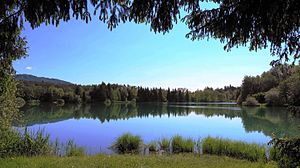Grünsee (Villach)
| Grünsee | ||
|---|---|---|

|
||
| Geographical location | Villach , Carinthia , Austria | |
| Tributaries | Groundwater | |
| Drain | no | |
| Data | ||
| Coordinates | 46 ° 37 '19 " N , 13 ° 53' 33" E | |
|
|
||
| Altitude above sea level | 490 | |
| surface | 1,757 ha | |
| length | 185 m | |
| width | 127 m | |
| volume | 62,543 m³ | |
| scope | 510 m | |
| Maximum depth | 6.6 m | |
| Middle deep | 3.6 m | |
The Grünsee is a 1.76 hectare pond in the urban area of Villach ( Carinthia ). It is part of the nature reserve of the same name .
The Grünsee is located on the eastern outskirts of Villach. It is a dead ice hole and was created at the end of the Würm Ice Age , when the Draugletscher disintegrated here and several bodies of dead ice remained, from which several lakes were formed.
Grünsee
The Grünsee is only fed by groundwater, it has no above-ground inflows or outflows. It has a size of 1.76 hectares and reaches a maximum depth of 6.7 meters. It is rich in nutrients ( eutrophic ). In early summer, green algae , dinoflagellates and cyanobacteria dominate , in midsummer the cyanobacteria alone dominate. The fish include pike, tench, carp, bream, catfish, perch, eel, aitel and roach, as well as a few other white fish.
The bank vegetation on the north bank consists of a narrow strip of Schneidried, behind which there is a fragmentary black alder forest . In addition, there are clumps of stiff sedge , reeds and water lilies in some places .
Turner moss
The Turner Moos, also located in the nature reserve, is an already heavily silted up dead ice hole. It is an intermediate moor and is populated by species of raised bogs and fens. At the edge are characteristic species the Schnabel-Sedge , further inside the White Schnabelried . In the center you will find typical raised bog species such as red peat moss , rosemary heather , cranberry , cotton grass and round-leaved sundew . Red pines appear on the Bülten .
More dead ice holes
There are still two dead ice holes. One of them, right next to the autobahn, resembles the Turner Moos. The second is next to the main road and is overgrown with reeds and great sedge. Occasional raised bog plants occur here.
Forest
Around 55% of the area of the nature reserve is taken up by forest. Spruce forest , which is heavily used for forestry, is dominant , some of which has been severely degraded and has undergrowth with few species. In addition to the spruce, there are also red pine , English oak and red beech .
Nature reserve
The Grünsee nature reserve was established in 1964, is 55 hectares in size and is privately owned. It is bounded in the north by Triester Straße B83, in the northeast by the Süd Autobahn and in the south by the Villach-Klagenfurt railway line. The Magdalensee connects to the west . The area is of particular importance as a recreational area. From a nature conservation perspective, the condition is classified as poor.
See also
supporting documents
- Helmut Hartl, Hans Sampl, Ralf Unkart: Carinthia's gems. National parks, nature reserves, landscape reserves, natural monuments . Kärntner Druck- und Verlagsgesellschaft, Klagenfurt 1993, ISBN 3-85391-092-0 , p. 78.
- Andrea Bulfon: Nature reserves in Austria. Volume 4: Carinthia, Styria . Monographs of the Federal Environment Agency 38D, Vienna 1993, pp. 37–40. ISBN 3-85457-092-9
